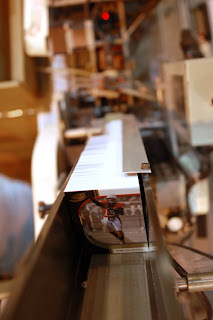To many of us, there are few things that compare to the insatiable pleasure of opening packs of trading cards. But have you ever wondered how those packs are made? Where do those shiny packages full of so much joy come from? Is it magic? I used to think so, and for those of you who are absolutely convinced that the trading cards you buy are packaged far away on the enchanting "Isle de Collectia" by magical elves, please stop reading now or may your visions of grandeur be forever tarnished.
It’s hot. The thermometer on the dash of the rental car shows an exhausting 105°. This is a place where thin blades of scorched grass crumble beneath your feet as you walk and the tar from the asphalt turns to liquid. Welcome to summertime in
Charlotte, NC to Dallas, TX 1,026 miles
After the cards are designed, built, approved, and printed. They’re sent to this facility for “pack-out” where a
Production Facility
First, all of the various base cards, inserts, autographs, and memorabilia cards are loaded into feeders on a production line. Throughout production, the feeders are constantly monitored and reloaded to keep everything running smoothly.
Top view of a card feeder on a production line
The feeders drop the cards at various insert rates onto a moving line. Each feeder is timed to drop its card(s) at exactly the right moment. Several tests are done prior to production to ensure that each feeder is dropping the right cards at the right time.
View of a trading card production line in action
The line quickly whisks the groups of cards down the line and into a machine that wraps and seals each pack.
Cards entering the wrapping machine
After the cards are wrapped, the packs pass across a scale which is designed to weigh each pack and catch any packs that have too many or too few cards before they go into the boxes.
Packs are weighed as they pass through the production line
From there, packs are sorted, shuffled, and inserted into the boxes by hand. Boxes are placed on a conveyor belt where they are shrink-wrapped and placed into cases.
Finished boxes being shrink-wrapped
After that, it’s pretty simple. The cases are shipped to customers, and then the fun begins!
Now that you have an idea of how the products you enjoy are made, you can appreciate them even more. Oh, and as for how we get actual signatures on the autograph cards without using sticker – well that truly IS magic.







2 comments:
Time to recalibrate! I bought over 70 loose retail 2009 Premium & Stealth packs today and and while none had too few cards several had 6 or 7 instead of the advertised 5. Mind you, I'm not complaining but that does cost you money, does it not?
Steven, thanks for your comment. The main purpose of this "behind-the-scenes" article is to show how the system is clearly not fail-proof. If a feeder is loaded improperly or if the rollers are pressing on the cards too hard issues are going to arise. On occasion, extra base cards will make it into packs. The scale's main function is to catch packs that are missing cards or contain an extra memorabilia card. Thanks again for your feedback. I hope the article was helpful.
Post a Comment